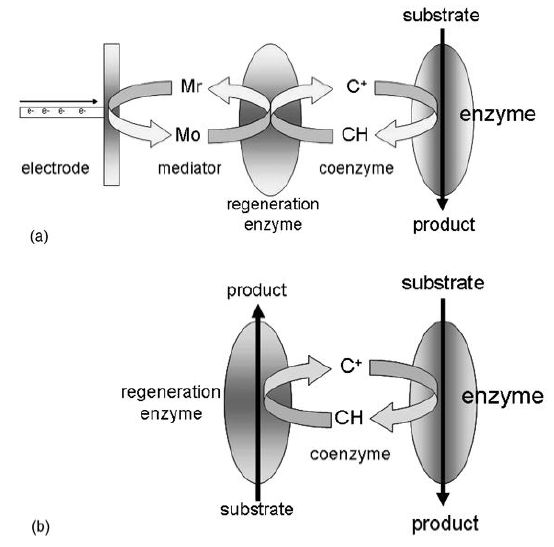
Coenzyme Regeneration
 المؤلف:
John M Walker and Ralph Rapley
المؤلف:
John M Walker and Ralph Rapley
 المصدر:
Molecular Biology and Biotechnology 5th Edition
المصدر:
Molecular Biology and Biotechnology 5th Edition
 الجزء والصفحة:
الجزء والصفحة:
 9-1-2021
9-1-2021
 2359
2359
Coenzyme Regeneration
Around 25% of enzymes are oxidoreductases and they catalyse many reactions that are of great interest to biotechnologists.
However, most of these enzymes require participation of a coenzyme such as NAD, NADH, NADP, NADPH or ATP. Coenzymes are chemically changed during reaction and so in effect become an expensive consumable. Hence efficient regeneration of coenzyme is essential

Figure 1. Diagram depicting coenzyme regeneration using (a) an electrode, regeneration enzyme and chemical mediator (Mr, reduced; Mo, oxidised) to recycle the coenzyme and (b) a regeneration enzyme in a reaction that utilises a secondary substrate.
for applications that utilise these enzymes. There are basically two mechanisms to regenerate coenzyme, as depicted in Figure 1. In the first method (Figure 1a), the coenzyme is regenerated electrochemically using electrons supplied from an electrode. To improve efficiency, a regeneration enzyme and chemical mediators are added to more effectively interact with the electrode. The second method (Figure 1b) does not use an electrode and instead uses a second enzyme that catalyses a reverse reaction to regenerate coenzyme. Use of a second enzyme reaction requires close coupling of the reaction kinetics of the secondary enzyme to match that of the primary enzyme reaction.
For example, if the rate of catalysis of the primary reaction is 500 mmol min-1 and the secondary enzyme catalyses at a rate of 200 mmol min-1, then the slower reaction will drag the primary reaction and lower the efficiency. On the other hand, if the secondary reaction is too fast (e.g. 2000 mmol min-1), then there would be inefficient and uneconomical waste of material. There are enzymes available that have been adapted for coenzyme regeneration to improve the efficiency of the process.
Many attempts have been made to immobilise coenzymes and enzymes together to try to produce a universal efficient biocatalytic system with continuous coenzyme regeneration and, although some systems work well, further innovation is still required to produce a fully efficient and effective system that will realise the full potential of all the valuable enzymes that have coenzyme requirements.
 الاكثر قراءة في الانزيمات
الاكثر قراءة في الانزيمات
 اخر الاخبار
اخر الاخبار
اخبار العتبة العباسية المقدسة


